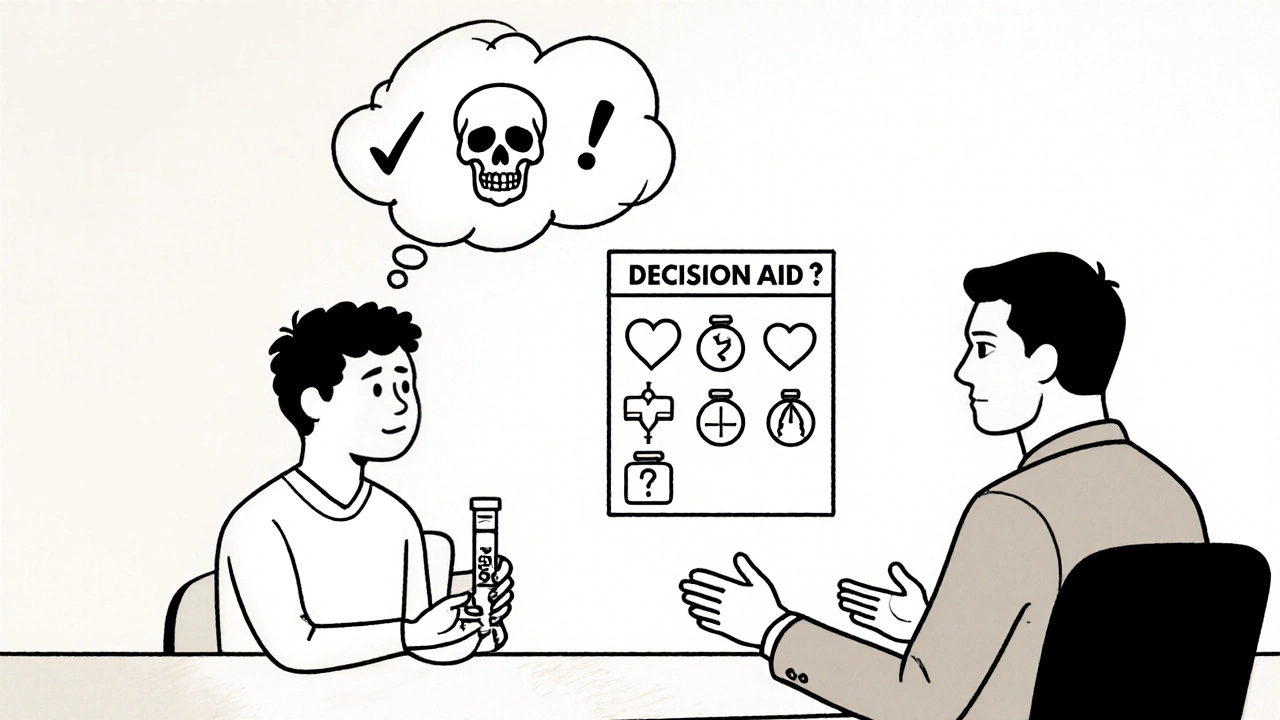PSA screening isn’t as simple as it seems
Every year, millions of men get a PSA test - a simple blood draw that measures prostate-specific antigen. For some, it’s a routine checkup. For others, it’s a life-or-death gamble. The truth? The PSA test doesn’t tell you if you have cancer. It tells you your prostate is acting up. And that’s where things get messy.
Back in the 1990s, doctors thought PSA screening was a miracle. Men were getting diagnosed early, treatment was working, and deaths were falling. But then came the hard data. Three massive studies involving over half a million men showed something shocking: PSA screening saves a few lives, but it also causes a lot of harm. For every 1,000 men screened over 10 years, about 1 to 2 prostate cancer deaths are avoided. But 100 to 120 men get false positives. Eighty to 100 are diagnosed with cancers that would never have hurt them. And many of those men end up with surgery, radiation, or other treatments that leave them incontinent, impotent, or both.
The U.S. Preventive Services Task Force flipped its stance twice. In 2012, it said: Don’t screen. By 2018, it changed to: Only screen if you and your doctor talk it through. That’s where shared decision-making comes in. It’s not a recommendation. It’s a requirement.
What the PSA test really measures - and why it’s flawed
PSA is a protein made by the prostate. High levels can mean cancer. But they can also mean you rode a bike yesterday, had a urinary infection, or are just getting older. About 75% of men with PSA levels between 4.0 and 10.0 ng/mL don’t have cancer. That’s a false alarm rate higher than most people realize.
And here’s the other side: 15% of men with aggressive prostate cancer have PSA levels below 4.0. That means the test misses dangerous cancers. It’s not just inaccurate - it’s misleading. The old cutoff of 4.0 ng/mL is outdated. Today, doctors use age-adjusted ranges: 2.5 for men in their 40s, 3.5 for their 50s, 4.5 for their 60s, and 6.5 for those 70 and over. But even those aren’t foolproof.
Some men get extra tests - PSA velocity (how fast levels rise), PSA density (PSA divided by prostate size), or newer blood markers like the 4Kscore. These help. But they’re expensive. The 4Kscore costs $400 to $600. A genomic test like Prolaris can hit $4,000. The PSA test? $20 to $50. It’s cheap. It’s everywhere. And that’s why it’s still the starting point - even when it’s wrong.
Screening doesn’t always mean treatment - and that’s the key
Not every prostate cancer needs to be treated. In fact, many don’t. The ProtecT trial followed over 1,600 men with early-stage prostate cancer for 10 years. Those who chose active surveillance - meaning regular scans and PSA checks, but no surgery or radiation - had the same survival rate as those who got treated: 99%. That’s not a fluke. It’s the norm.
Active surveillance is now standard for low-risk cancers. But here’s the problem: most men don’t know it’s an option. They hear “cancer” and panic. They rush into surgery. One 62-year-old man in a 2020 study had his prostate removed after a PSA of 4.7. He later learned his cancer was slow-growing. He spent the next decade dealing with incontinence and erectile dysfunction - all for a tumor that would’ve never bothered him.
That’s why tools like multiparametric MRI are changing the game. Before a biopsy, doctors can now scan the prostate to see if there’s a suspicious area. The PRECISION trial showed using MRI first cuts unnecessary biopsies by 27%. That’s huge. Fewer needles. Fewer infections. Fewer false alarms.
Who benefits most from PSA screening?
Not everyone. The data shows clear patterns. Men aged 55 to 69 get the most benefit - and the least harm. For men under 55, the risk of overdiagnosis outweighs the chance of catching something deadly. For men over 70, the chance of dying from prostate cancer is low. The chance of dying from treatment side effects? Much higher.
But race changes everything. African American men are 70% more likely to get prostate cancer and more than twice as likely to die from it. Yet they’re 23% less likely to get a full shared decision-making conversation before screening. That’s not just a gap - it’s a crisis.
Family history matters too. If your father or brother had prostate cancer before 65, your risk jumps. Baseline PSA at age 45 can predict your future risk. A 2022 study found that men with a PSA under 1.0 ng/mL at age 45-50 have such a low lifetime risk they can safely wait until 55 to start screening. That’s a game-changer. It means you don’t need to test every year - just once, early, to set your trajectory.
Why shared decision-making isn’t happening - and how to fix it
Doctors say they talk about PSA screening. Patients say they don’t. A 2017 national survey found only 60% of men reported getting even one piece of information about the risks and benefits. A 2022 Mayo Clinic study showed primary care doctors spend just 3.7 minutes on this topic during a yearly visit. That’s less time than it takes to refill a prescription.
Decision aids help. The Ottawa Personal Decision Guide, the Mayo Clinic’s visual risk tool, and the Prostate Cancer Foundation’s patient resources all show the same thing: when men see clear numbers - like “1 in 1,000 men avoid death, but 240 get unnecessary biopsies” - they make better choices. Decisional conflict drops by 35%. Men feel less pressure. They understand trade-offs.
But most clinics don’t use them. Only 38% of U.S. healthcare systems have standardized shared decision-making protocols. And only 29% of primary care doctors feel trained to have these conversations. Urologists? Better. But they’re not the ones ordering the test. Your family doctor is.
Training programs like the American Urological Association’s SDM curriculum have certified over 2,000 urologists since 2018. But unless primary care gets the same tools, the gap stays wide.

The future of prostate cancer screening - and why PSA won’t disappear yet
Next-generation tests are coming. IsoPSA, approved by the FDA in 2021, claims 92% accuracy in spotting aggressive cancers - compared to just 25% for traditional PSA. AI models, like the one from MIT that analyzes routine blood work, can predict prostate cancer risk with 85% accuracy. That could cut unnecessary PSA tests by 30%.
Genetic testing is also gaining ground. The BARCODE1 study found men with certain gene variants benefit far more from screening. That means in the future, screening won’t be for everyone - just those at high risk.
But here’s the reality: none of these new tools are widely available. They’re expensive. Insurance doesn’t always cover them. And even the best test can’t tell you if a cancer will kill you - only if it might. That’s why shared decision-making isn’t going away. It’s becoming more important than ever.
As Dr. David Penson of Vanderbilt says: “Until we have better tools to distinguish lethal from indolent cancers, shared decision-making remains our most important intervention.”
What you should do - step by step
If you’re a man between 45 and 69, here’s what to do:
- Know your risk. Are you African American? Do you have a father or brother who had prostate cancer before 65? If yes, start the conversation now.
- Ask for a baseline PSA. At age 45, get one test. If it’s under 1.0 ng/mL, you can wait until 55. If it’s higher, talk about next steps.
- Ask for a decision aid. Don’t rely on your doctor’s memory. Ask: “Can you show me the risks and benefits in numbers?” Use the Ottawa Personal Decision Guide or the Mayo Clinic’s tool.
- Understand active surveillance. If cancer is found, ask: “Is this low-risk? Can I monitor it instead of treating it?”
- Don’t rush. This isn’t an emergency. Take a week. Talk to your partner. Come back with questions.
If you’re over 70, and you’ve never been screened, the odds are you won’t benefit. If you’ve been screened for years, talk to your doctor about stopping.
If you’re under 45, skip the test - unless you have a strong family history. Even then, wait until 45.
What’s really at stake
PSA screening isn’t about whether you should get a test. It’s about whether you’re making an informed choice. The data doesn’t lie: screening saves a few lives. But it also creates a lot of suffering. The difference between those outcomes? A conversation.
Men who understand the trade-offs are less likely to be overtreated. They’re more likely to choose active surveillance. They’re more likely to live well - even if they have cancer.
And that’s the real goal: not just living longer, but living better.
Is PSA screening still recommended?
Yes - but only for men aged 55 to 69, and only after a full discussion with a doctor about the risks and benefits. For men under 55 or over 70, routine screening is generally not recommended unless there’s a strong family history or other high-risk factors.
Can PSA screening miss aggressive prostate cancer?
Yes. About 15% of men with high-grade, life-threatening prostate cancer have PSA levels below 4.0 ng/mL. That’s why a normal PSA doesn’t mean you’re safe. Newer tools like multiparametric MRI and genetic risk scores are helping fill this gap.
What are the main risks of PSA screening?
The biggest risks are false positives (leading to unnecessary biopsies), overdiagnosis (finding cancers that would never cause harm), and overtreatment (surgery or radiation that causes incontinence, erectile dysfunction, or other side effects). For every 1,000 men screened over 10 years, 80 to 100 are diagnosed with cancers that would never have been dangerous.
What is shared decision-making for PSA screening?
Shared decision-making is a conversation between you and your doctor where you both discuss the benefits, risks, and alternatives to PSA screening. You’re not just told to get tested - you’re given clear, understandable information so you can choose what’s right for you. Tools like decision aids and risk calculators are part of this process.
Should I get a PSA test if I have no symptoms?
If you’re between 55 and 69, yes - but only after a shared decision-making conversation. If you’re under 55 or over 70, the answer is usually no - unless you’re at high risk. Prostate cancer often has no symptoms until it’s advanced. That’s why screening is controversial: it finds cancer before symptoms appear, but often finds harmless cancer too.
What are alternatives to PSA screening?
Multiparametric MRI before biopsy, the 4Kscore blood test, PCA3 urine test, and genomic tests like Oncotype DX GPS can improve accuracy. But they’re not replacements for PSA - yet. They’re used to better interpret PSA results or avoid unnecessary biopsies. The future may involve AI-driven risk models combining PSA, genetics, and lifestyle data.
Why are African American men at higher risk?
African American men have a 70% higher incidence of prostate cancer and more than double the death rate compared to white men. The reasons aren’t fully understood, but likely involve genetics, access to care, and systemic disparities in screening and treatment. They’re also 23% less likely to receive a full shared decision-making conversation - making early detection and informed choices harder.
Can I avoid treatment if I’m diagnosed with prostate cancer?
Yes. For low-risk prostate cancer, active surveillance is now the standard of care. This means regular PSA tests, MRIs, and occasional biopsies - but no surgery or radiation unless the cancer shows signs of becoming aggressive. Studies show survival rates are just as good as with immediate treatment.






vanessa k
I had my PSA done last year at 58. Turned out to be 5.2. Got biopsied, turned out to be low-grade. Now I'm on active surveillance. No surgery. No radiation. Just yearly scans. My wife says I'm lucky to still be sleeping in the same bed as her. The fear of 'cancer' made me rush. The data made me pause. Don't let panic make your choices.
manish kumar
I come from India where PSA screening is not routine at all and most men only get tested when they have symptoms, which is often too late. But reading this article made me realize that even in a country with limited healthcare access, the principle of informed choice matters more than ever. The fact that 15% of aggressive cancers show up with low PSA levels is terrifying. We need better tools, yes, but we also need to stop treating a number like it's a verdict. It's a starting point. A conversation starter. Not a death sentence. And if we can teach men to ask for decision aids instead of just accepting the test as gospel, we might actually save lives without ruining them.
Nicole M
My dad got diagnosed at 63 after a PSA of 6.8. They did the biopsy, the MRI, the whole thing. Turned out it was low risk. He chose surveillance. Now he hikes every weekend. He never had incontinence. Never had ED. He just got smarter about his health. I wish more doctors would hand out those decision aids like they hand out aspirin. It's not about fear. It's about clarity.
Arpita Shukla
Actually, the 4Kscore isn't $400-$600, it's closer to $800 in most US hospitals due to lab fees and markup. And Prolaris? That's $4,000 only if you're uninsured. With insurance, it's often $1,200 out of pocket. Also, multiparametric MRI isn't cutting biopsies by 27% universally-only in high-volume centers with experienced radiologists. Most community hospitals don't have the training or equipment. So while the data looks great on paper, real-world implementation is a mess. Don't let glossy studies fool you.
Benjamin Stöffler
The real issue isn't PSA-it's the medical-industrial complex's addiction to intervention. We are wired to fix, to cut, to zap, to cure. But cancer isn't always a problem to be solved-it's sometimes a condition to be managed. And yet, we treat it like a fire in a building that must be extinguished immediately, even if the fire is just a candle in a corner. Shared decision-making isn't a policy-it's a philosophical shift. From 'we know best' to 'what do you value?' And until we stop pathologizing aging-and prostate tissue-we'll keep turning benign biology into medical trauma.
Mark Rutkowski
There’s a quiet dignity in choosing to live with a quiet threat rather than destroy your life chasing a ghost. I’ve watched too many men trade their mornings-walking the dog, tying their shoes, holding their grandkids-for a shot at a number that might, maybe, save them. But what’s the point of living longer if you can’t feel your own skin anymore? The real enemy isn’t prostate cancer. It’s the myth that every cell out of place must be eradicated. Sometimes, the bravest thing you can do is sit still. Let the body breathe. Let the years pass. And trust that not every shadow is a storm.
Ryan Everhart
So let me get this straight. We’ve got a test that’s wrong more than it’s right, causes more harm than good, and costs billions… but we still do it because it’s cheap and easy? And the solution is… talking? Wow. What a breakthrough. Next you’ll tell me we should ask people if they want to breathe before giving them oxygen.
David Barry
The data’s clear. PSA screening is a public health liability. But here’s what nobody says: urologists make bank off biopsies and surgeries. Hospitals get reimbursed for procedures, not conversations. And primary care docs? They’re paid by the minute. A 3.7-minute discussion doesn’t generate revenue. So the system incentivizes testing, not thinking. The solution isn’t better tools-it’s dismantling fee-for-service medicine. Until then, shared decision-making is just a pretty word for performative empathy.
Alyssa Lopez
I work in healthcare policy and let me tell you-this whole PSA debate is a liberal fantasy. Men need to be told what to do, not asked. We're losing the war on cancer because we're coddling men with 'informed choice.' If you're 55+, you get the test. Period. The 23% gap for African American men? That's a systemic failure of access, not a failure of consent. Fix the system, not the conversation. And stop pretending we need fancy MRI scans and $4K tests. We're not in Sweden. We need simple, bold, American solutions.